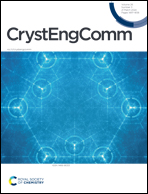Piezoelectric properties of (Sr0.2Ca0.8)3TaGa3Si2O14 and Ca3TaGa3Si2O14 single crystals grown via vertical Bridgman method†
Abstract
CTGS crystals are widely used in the field of high-temperature piezoelectricity because of their excellent piezoelectric properties. In this paper, the Ca2+ lattice of CTGS crystals is replaced by Sr2+ with a larger radius to improve their piezoelectric properties. (Sr0.2Ca0.8)3TaGa3Si2O14 and Ca3TaGa3Si2O14 single crystals with a diameter of 25 mm were grown using the vertical Bridgman method. The full width at half maximum (FWHM) of X-ray rocking curves of SCTGS and CTGS crystals are 57.6′′ and 22.3′′, respectively. It was found that the thermal properties of SCTGS crystals, such as specific heat, thermal diffusion and thermal conduction, are slightly lower than those of CTGS crystals. At room temperature, the dielectric permittivity εT11 increased from 18.59 to 18.78, and the piezoelectric coefficient d11 also increased from 4.22 pC N−1 to 4.54 pC N−1. The electrical resistivities of the X-cut plates of SCTGS and CTGS crystals are approximately 3.78 × 107 Ω cm and 2.40 × 107 Ω cm at 800 °C, respectively. Therefore, SCTGS will be a promising candidate piezoelectric material in the field of high-temperature sensing.



 Please wait while we load your content...
Please wait while we load your content...